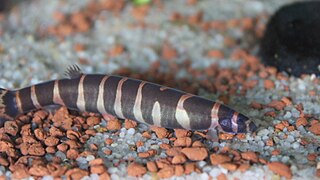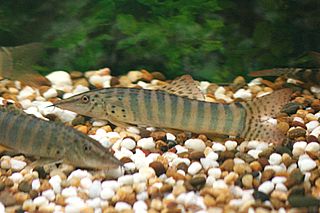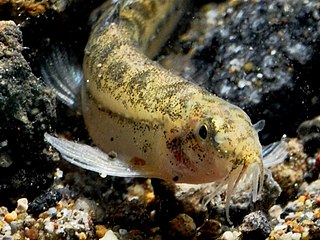
Cypriniformes is an order of ray-finned fish, which includes many families and genera of cyprinid fish, such as barbs, gobies, loaches, botias, and minnows. Cypriniformes is an “order-within-an-order”, placed under the superorder Ostariophysi—which is also made up of cyprinid, ostariophysin fishes. The order contains 11-12 families, over 400 genera, and more than 4,250 named species; new species are regularly described, and new genera are recognized frequently. Cyprinids are most diverse in South and Southeast Asia, but are entirely absent from Australia and South America. At 112 years old, the longest-lived cypriniform fish documented is the bigmouth buffalo.

Cobitidae, also known as the True loaches, is a family of Old World freshwater fish. They occur throughout Eurasia and in Morocco, and inhabit riverine ecosystems. Today, most "loaches" are placed in other families. The family includes about 260 described species. New species are being described regularly.

The hillstream loaches or river loaches are a family, the Balitoridae, of small fish from South, Southeast and East Asia. The family includes about 202 species. They are sometimes sold as "lizardfish" or "flossensaugers". Many of the species are popular for aquaria, species in the genus Sewellia are most commonly sold in the aquaria trade. They have a number of similarities with the Cobitidae, their sibling family of "loaches", such as multiple barbels around the mouth. They should not be confused with the loricariids, which look similar but are a family of catfish.

Pangio is a genus of small Asian freshwater fish in the true loach family Cobitidae. In earlier taxonomic schemes it was known as Acanthophthalmus. The "kuhli loach" is well-known in the aquarium trade and commonly identified as P. kuhlii, but most individuals actually appear to be P. semicincta.

Yasuhikotakia is a genus of botiid loaches, many which are popular aquarium fish. It is named in honor of Japanese collector/researcher Dr. Yasuhiko Taki. This genus has been separated from the genus Botia in the paper by Maurice Kottelat in 2004.
The Küçük Menderes spined loach, Cobitis fahireae is a species of loach endemic to Turkey where it occurs in intermittent rivers.

Lepidocephalichthys is a genus of ray-finned fish in the family Cobitidae.

Botiidae is a family of cypriniform ray-finned fishes from South, Southeast, and East Asia. Until recently they were placed in the true loach family Cobitidae, until Maurice Kottelat revised the loaches and re-elevated this taxon to family rank in 2012. The family includes about 56 species.
Schistura prashadi is a species of ray-finned fish, a stone loach, in the genus Schistura. Some authorities place it in the genus Physoschistura It is known from just three localities in the Chindwin River drainage in Manipur, India. It is a benthic species of hill streams, preferring well oxygenated, clear, flowing water.
Oxynoemacheilus samanticus, the Kizilirmak sportive loach, is a species of ray-finned fish in the genus Oxynoemacheilus. It is found in streams and rivers with a fast current over gravel substrate and is endemic to eastern Anatolia, Turkey where it is found in the Kizilirmak system which drains into the Black Sea, as well as the headwaters of the Euphrates.

Schistura semiarmata is a species of stone loach in the genus Schistura. It is found in the Indian states of Karnataka, Kerala, and Tamil Nadu and, at least based on some sources, in Pakistan. It grows to 5.6 cm (2.2 in) SL. It is a very common species inhabiting high altitude streams with hard bottom. It is sometimes used as an aquarium fish.
Schistura sexcauda is a species of ray-finned fish, a stone loach, in the genus Schistura. It is found in the basin of the Chao Phraya River in central Thailand where it has been recorded in streams with a moderate to fast current and in riffles, over substrates consisting of gravel to stone. It is known to be raised in local subsistence fisheries and traded both nationally and internationally as an ornamental fish.
Yunnanilus altus is a species of ray-finned fish, a stone loach, in the genus Yunnanilus from Yunnan. It occurs in small streams with a moderate current where it moves slowly in shoals along the substrate. Its diet consists of filamentous algae and insects. The type locality is in Zhanyi County.
Yunnanilus analis is a species of ray-finned fish, a stone loach, in the genus Yunnanilus. The type locality is Xingyun Lake in Yunnan, southern China. The specific name analis means "of the anus" and refers to the six branched rays in the anal fin, a unique feature among the species classified under Yunnanilus.
Yunnanilus discoloris is a species of ray-finned fish, a stone loach, in the genus Yunnanilus. It is currently only in a single spring in the drainage basin of Lake Dianchi in Yunnan.
Yunnanilus longibulla is a species of ray-finned fish, a stone loach, in the genus Yunnanilus. The type locality for this species is Chenghai Lake in Yunnan. The specific name longibulla means "long bubble" and refers to the elongated shape of the swim bladder compared to closely related species.
Yunnanilus macrolepis is a species of stone loach which is endemic to China. Its type locality is Luoping County in Yunnan. Some authorities consider Y. macrolepis to be a junior synonym of Yunnanilus paludosus.
Yunnanilus nanpanjiangensis is a species of ray-finned fish, a stone loach, in the genus Yunnanilus. It is endemic to China and uts type locality is near Agang Town, Luoping County, Yunnan and the specific name refers to the Nanpanjiang River.

Loaches are fish of the superfamily Cobitoidea. They are freshwater, benthic (bottom-dwelling) fish found in rivers and creeks throughout Eurasia and northern Africa. Loaches are among the most diverse groups of fish; the 1249 known species of Cobitoidea comprise about 107 genera divided among 9 families.

Lepidocephalichthys hasselti is a species of cobitid loach native to southeastern Asia and western Indonesia. This species reaches a length of 45 millimetres (1.8 in) TL.










